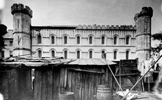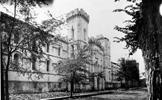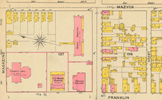Charleston maintained a City Hospital, primarily supported by appropriations from City Council, located in a brick building that in antebellum days had been known as the Workhouse, at the corner of Mazyck and Magazine streets. Before the Civil War, enslaved men and women had been sent to the Workhouse as punishment for various offenses. There they sometimes were whipped or tied to a treadmill and on rare occasions executed.
It was an unlikely location for a health-care facility. Even in 1886 the old Workhouse was a dank and airless old hulk with no place to isolate those suffering from fevers and communicable diseases. In 1886, 1,070 patients were admitted to the hospital, 55 percent of them black. The vast majority received free treatment, many of them coming from outside of Charleston County, as neither the state nor any other county provided funds for indigent care.
So bad was the reputation of City Hospital that Charlestonians regularly went out of their way to avoid it. The night of the earthquake, a man injured just across the street crawled five blocks to Washington Square looking for a physician.
The night of the earthquake, the walls of the City Hospital crumbled and heavy buttresses fell to the ground. Two of the 125 patients were killed in the falling rubble. In the aftermath, bodies sprawled on doors and shutters torn from wrecked buildings for use as stretchers.
The next day, when the building was declared unsafe, Dr. Arthur B. Rose, chairman of the Agricultural Society of South Carolina, offered the use of the society’s large hall on Meeting Street (now the site of the Gibbes Museum of Art). Rose gave permission to convert the hall, which appeared to be structurally sound, to hospital wards. Just after noon on Wednesday, a caravan of wagons holding patients began rolling the three blocks from the ruined hospitals to their new temporary location. The Agricultural Hall was partitioned with cloth to make separate compartments for white and black patients, and for men and women. There were no privies and no running water, yet the Charleston News and Courier marveled that the makeshift hospital was “a model of neatness.”
The earthquake provided Mayor William Ashmead Courtenay with the opportunity he wanted to remake the City Hospital, though the site chosen for the new building was on reclaimed marshland along the banks of the Ashley River. No one in town pointed out that if another large earthquake hit, this location would be just as treacherous as the unstable filled creek beds that had torn apart the old hospitals, the jail, and the medical college. But construction on what became known as Memorial Hospital, at the corner of Lucas (now Jonathan Lucas) and Calhoun streets, began about six months after the earthquake. The old City Hospital was torn down early in 1887, and Memorial Hospital opened in 1888.
News and Courier, Friday morning, September 3, 1886:
“The City Hospital was badly wrecked and it is stated that several of the inmates were killed. A number of the patients were injured. These were all taken out of the building and passed the night in the open air.
Ten patients severely and some mortally wounded are in the Hospital, six white and four colored. They present a terrible spectacle. At the Hospital was also the body of a colored man, who was killed by a falling piazza, and the body of Mr. Robert Alexander, the young English analytical chemist, was sent there horribly mangled.
The patients of the Hospital have been moved from the wards to safer one-story buildings formerly used as wash and dining-rooms.”



